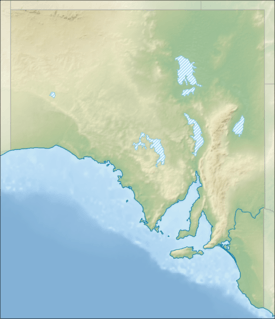Yumbarra Conservation Park
| Yumbarra Conservation Park South Australia | |
|---|---|
|
IUCN category VI (protected area with sustainable use of natural resources) | |
 Malleefowl | |
 Yumbarra Conservation Park | |
| Nearest town or city | Ceduna |
| Coordinates | 31°39′15″S 133°33′38″E / 31.65417°S 133.56056°ECoordinates: 31°39′15″S 133°33′38″E / 31.65417°S 133.56056°E |
| Established | 30 May 1968[1] |
| Area | 3,243.52 km2 (1,252.3 sq mi)[1] |
| Managing authorities | Department of Environment, Water and Natural Resources |
| Website | Yumbarra Conservation Park |
| See also | Protected areas of South Australia |
The Yumbarra Conservation Park is a protected area in South Australia located about 30 kilometres (19 mi) north of Ceduna. To the north it borders Yellabinna Regional Reserve, to the east Pureba Conservation Park. The conservation park is outside of the dog fence, which borders it in the south. Therefore, it is situated in the area, where dingoes are tolerated. Other animals in the conservation park include southern hairy-nosed wombats, malleefowls, sandhill dunnarts and kangaroos.
The name 'Yumbarra' comes from a protruding rock hole in the area. When it rains, the rock fills with water, turning into a temporary water hole for the conservation park's wildlife. This particular feature of the rock makes it an important site for birds, and thus bird watching.[2]
The arid landscape is characterized by rolling sand dunes. The Googs Track, a 120 kilometres (75 mi) long 4 wheel drive road, goes through the conservation park heading to the Yellabinna Regional Reserve in the north towards Googs Lake. A few walking trails follow the Googs Track.
The conservation park is an important habitat for some of Australia's most endangered wildlife species, such as the malleefowl and sandhill dunnart. The conservation park is also home to kangaroos, wombats and dingoes.[2]
The conservation park is classified as an IUCN IUCN Category VI protected area.[3]
See also
References
- 1 2 "Protected Areas Information System - reserve list (as of 16 July 2015)" (PDF). Department of Environment, Water and Natural Resources. Retrieved 3 August 2015.
- 1 2 "Yumbarra Conservation Park". Department of Environment, Water and Natural Resources, South Australia. Retrieved 29 July 2013.
- ↑ "Terrestrial Protected Areas of South Australia (see 'DETAIL' tab)". CAPAD 2012. Australian Government - Department of the Environment. 2014. Retrieved 13 March 2015.
External links
- Yumbarra Conservation Park - Department for Environment and Heritage
- Yumbarra Conservation Park page on protected planet